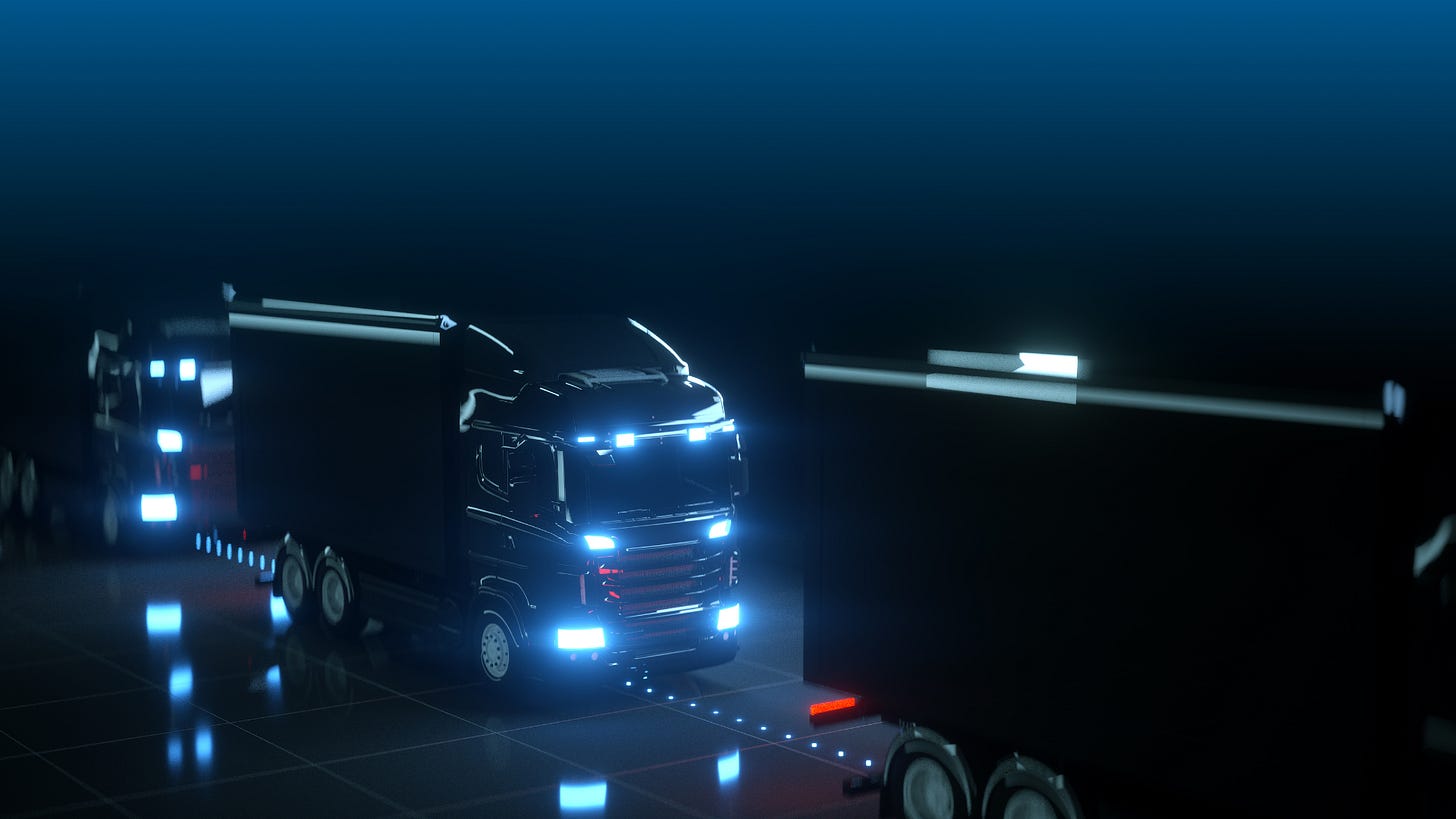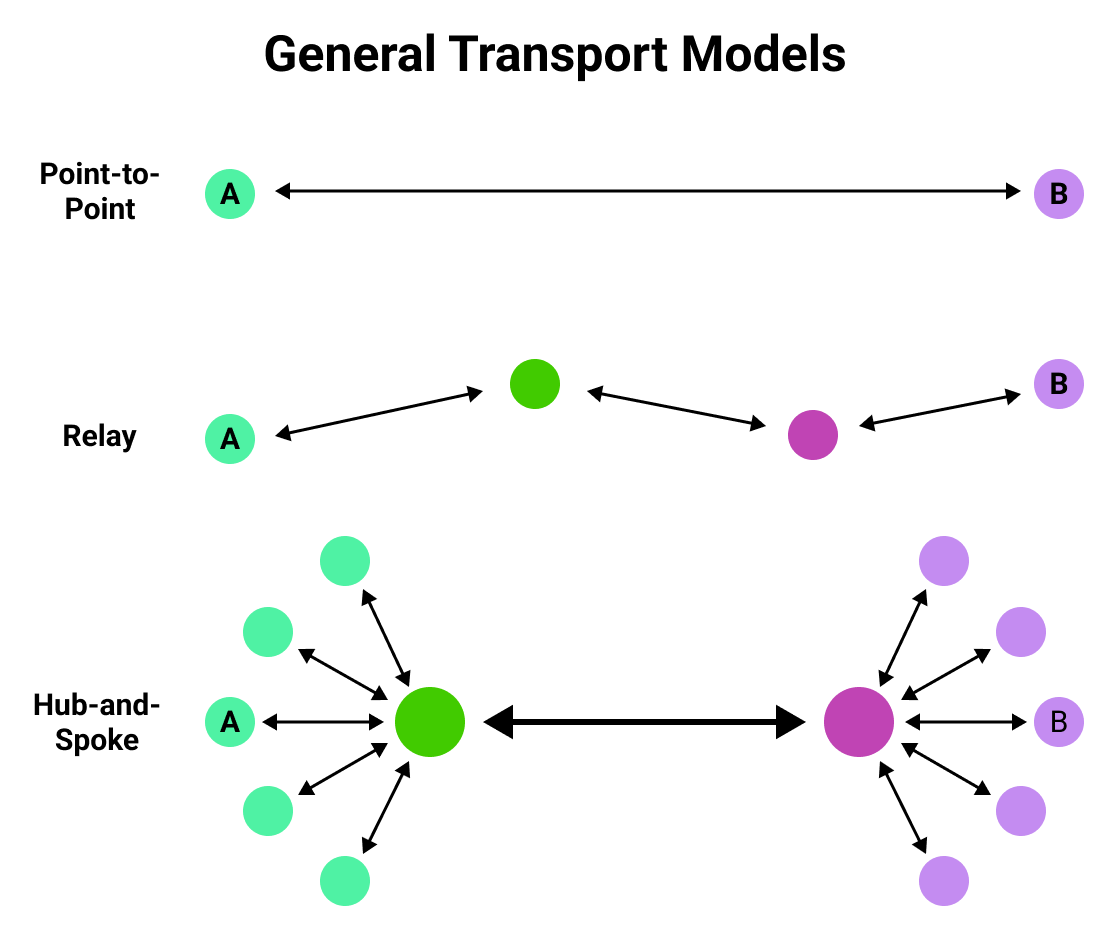Two stories from different continents with a surprising commonality caught my attention: American company’s Kodiak Robotics plans for an 800 strong autonomous truck network in collaboration with Loadsmith in the US, and Spanish company’s Trucksters idea to segment long-haul truck journeys into 4.5-hour long trips by transferring cargoes between trucks located in exchange centers.
Kodiak’s idea is to use autonomous trucks for the highway driving component of long-haul routes and to supplement the in-city driving or the last-mile logistics with human drivers. Kodiak’s business model would be to sell the self-driving feature of their trucks as-a-service – essentially a fee/mile driven for using the self-driving feature.
Trucksters’ idea is that by segmenting long-haul trips into relays would allow drivers to spend more time at home rather than sleeping in the trucks, therefore improving their quality of life while (and this is an important component) being more aligned with the capabilities of their electric trucks.
Although both stories are quite different, they have something important in common: both show incremental progress in the struggle to adapt to new technologies – autonomous driving and battery electric technology.
One Does Not Just Automate Driving in Complex Environments
Kodiak’s idea of using autonomous driving primarily for the highway component of a trip is an ingenious way to circumvent the issues posed by city environments on self-driving technology. Highway driving is relatively homogeneous in terms of signage and road markings, making the self-driving task somewhat easier to automate. City or industrial environments have much more heterogeneous features – some roads may have clear markings, others may not, pedestrians may cross at any point in time (on crossings or not), other cars may turn, in permitted or unpermitted areas. Implementing self-driving features in such environments is considerably more challenging. So, Kodiak decided to avoid this issue altogether.
The key advantage of only automating highway driving for transporters is that it optimizes the use of truck drivers’ time while presumably allowing them to spend less time sleeping in trucks. An hour of a truck drivers’ time costs the same whether it is spent cruising on a highway or navigating more complex city environments. Computers are typically well suited at dealing within ‘closed’ environments (i.e., subjected to fewer uncontrolled forces) and highways are the closest thing there is to a closed environment when it comes to road transport. Truck drivers are also useful for handling non-driving issues such as documentation, safety checks and so on, which can be automated, albeit at quite a high cost.
By automating the highway component driving from long-haul trips, truck operators also stand to make some weight and fuel efficiency improvements. Trucks would no longer require sleeper cabs and consequently the weight and space associated with the ‘bed-on-wheels’.
By selling the self-driving feature as-a-service, there is a direct proportional link between miles driven and the cost of self-driving these miles. This pricing model is antithetical to the idea of economies of scale which has, so far, driven most economic gains in logistics.
It is unclear whether Kodiak’s idea will actually lead to cost savings for Loadsmith (beyond those from using non-sleeper cabs). By selling the self-driving feature as-a-service, there is a direct proportional connection between the amount of miles driven and the cost of self-driving these miles. This pricing model is antithetical to the idea of economies of scale which has, so far, driven most economic gains in logistics. Using the self-driving feature may be cheaper initially than using a human driver, but I am not sure whether that advantage will persist over time. Consider that, in the as-a-service business model, truck drivers are unlikely to be considered owner-operators hence would likely be classified as employees rather than subcontractors, meaning that they may need to be paid while not driving. Furthermore, by purchasing the access to the self-driving feature from an external technology provider (Kodiak), Loadsmith may find itself dependent on the provider and hence unable to fight back against price increases. This may significantly change the logistics cost equation.
The Electric Pony Express
Trucksters’ approach to breaking up long-haul trips (over 6 hours long) into shorter, 4-hour segments is especially interesting from a driver quality of life, cost, and technology limitation perspectives. By transforming long-haul into a relay service where cargoes are passed on from truck to truck – a veritable pony express – drivers would be no longer required to sleep in their trucks nor spend time away from home because they can return home at the end of each shift. This quality-of-life improvement may help improve driver retention and potentially enhance the appeal of the profession. From a cost perspective, the relay idea should help reduce capital costs (no sleeper cabs) and reduce transport costs by minimizing empty return trips (on the hub-and-spoke principle). From a technology limitation perspective, the important thing about Trucksters is that they teamed up with Volvo to use their battery electric trucks which have a range of around 4-500 km. (Not so) coincidentally, that is close to the mileage that is achievable in 4.5 hours of driving.
The idea of a relay service in transportation may be somewhat new to trucking but is not new for other sectors. In the 1800s’, the Pony Express was an express mail service which reduced travel time for messages between the US East and the West Coasts to just 10 days. Airlines, especially in the US, and container shipping services use a modern version of the relay service, called hub-and-spoke, which allows them to take advantage of the economies of scale of larger aircraft and vessels.
The digital age paradox - data are moving quicker than ever while supply chains are slowing down.
Truckters’ relay transport model also has some disadvantage. Transport time is probably the biggest issue. To give you an idea of the magnitude of this potential issue, I’ll give some examples from air travel and container transport where this model is used. A 3-hour point-to-point direct flight from Los Angeles to Kansas City with Delta or Spirit takes 5.5 hours with United or American because of the indirect flight through their hubs in Denver and Dallas respectively. That’s an 83% longer trip time. Shipping a container from Belawan, Indonesia, to Bilbao, Spain takes 33 days on MSC Bengal loop which involves around 6 days of transshipment time. Containers on this route wait 20% of the transit time – if everything goes to plan. In all likelihood, the Trucksters relay service will have the same drawbacks. A 6-hour truck trip between Barcelona, one of Spain’s largest container ports and Madrid, the country’s capital, may well turn into an 8 or 10-hour one. This is the digital age paradox; data are moving quicker than ever while supply chains are slowing down.
Intended and Unintended Consequences of Technology
New technologies such as autonomous driving, and to some lesser extent battery electric vehicles, have been touted as having the potential to fundamentally transform logistics and supply chains. This fundamental transformation has failed to materialize just yet. However, Kodiak Robotics and Trucksters business models are illustrative of the incremental transformation which autonomous driving and battery electric vehicles may bring in logistics. Automating highway driving and breaking up long-haul trips into short-haul relay services are both incremental adaptations which try to augment human labor in transportation rather than replacing it. These incremental adaptations always have both intended and unintended consequences.
The intended consequences in both cases are clearly to reduce costs and, in the case of Trucksters, to create a transport system which transforms the range limitations of battery electric vehicles into strengths. Whether intended or not, both business models may end up improving drivers’ quality of life by reducing the time drivers must spend away from homes. These intended consequences run much in the classical direction of technological advancements – reduced costs and improved comfort.
Most technology implementations also have unintended consequences – some more obvious but overlooked, others potentially less obvious. In Scotland’s recent introduction of driverless busses, the staff requirements for operating a bus increased from one to two. Autonomous driving increased jobs. This is a bit tongue-and-cheek but illustrates the point that technology may not always generate benefits by displacing human labor. Should relay trucking services such as Trucksters’ be adopted en-masse, they may have as an unintended consequence the revival of regional communities. Just as highways spurred the consolidation of populations in urban environments, so can the range limitations of battery electric vehicles facilitate population dispersion in regional centers in proximity to relay. Drivers and support services (including tech support and roadside assistance) as well as logistics facilities may slowly relocate in regional areas closer to relay points.
Maybe that’s just optimistic thinking but, along with intended consequences, technology almost always has unintended consequences.
There’s nothing more rewarding than feedback from my readers!
Please leave a comment!
In Other News
The Link Between Carbon Emissions and Sea Levels May Not Be So Strong After All
This paper argues energy systems decarbonization due to anthropogenic CO2 concentrations effects on sea levels. The authors argue that existing sea level models are too obtuse by looking solely at the last several hundred years of human history and that the timeframe should be expanded. Consequently, the authors investigate the last 20,000 years of human history along with temperature changes and sea levels. The paper caught my attention not for the fatalistic projections of temperature and sea level rise but for the estimates it presents on past temperatures and sea levels.
While CO2 concentrations have only spiked in the past two hundred years, sea levels have been rising independently of anthropogenic carbon emissions for 20,000 years

The first figure shows “Past and future changes in concentration of atmospheric carbon dioxide and global mean temperature” and is split in five parts from A to E. Focus here solely on the ‘known’ data prior to today. Part A shows that change in surface temperature. If you take for instance 21,000 years ago and 6,000 years ago, you notice that the temperature has increased, in some places by 10 degrees, and that’s with a limited increase in CO2 concentrations (and definitely no anthropogenic CO2) in Part B. The graph in Part C illustrates ‘temperature abnormalities’ which I suspect are different than surface temperatures and which are also increasing somewhat uncorrelated with CO2 concentrations.

The second figure illustrates “Past and future changes in global mean sea level”. Notice in Part A of this figure that sea levels have been recorded to have risen by approximately 150 meters in the last 20,000 years. While CO2 concentrations have only spiked in the past two hundred years, sea levels have been rising independently of anthropogenic carbon emissions for 20,000 years.
Thanks, Paul, for pointing out the paper!
The Safest Place on the Internet is Offline
Google is (experimentally) cutting internet access to its staff in an effort to improve cybersecurity. This is ironic and paradoxical at the same time. Google, the company which makes close to every cent of its revenue from online-based services, is cutting internet access to its staff. Google, the same company pushing cloud transformation services to businesses worldwide which move business information on the internet, is considering whether the internet is not a very secure place and that the best cybersecurity protection is actually disconnecting from the internet.
ChatGPT’s Response Quality Struggle
Apparently the quality of ChatGPT responses to prompts have been consistently declining since the release of the software. One reason hypothesized for this decline in quality was the increase verbosity – the length of the code, which, in the case of coding prompts, could result in otherwise functional code blocks failing. One major issue with extremely powerful technology is that those who control it may not want to make available its full potential to others, even when others pay. If you do have other thoughts, I’m all ears!








